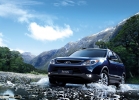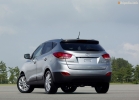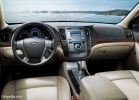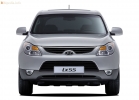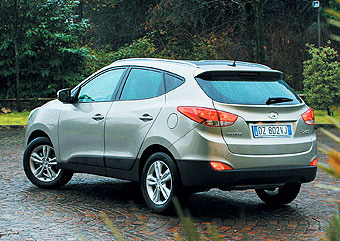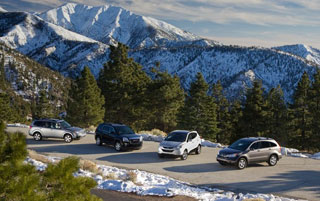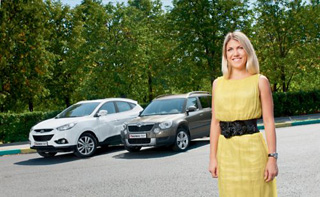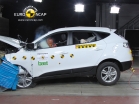Hyundai IX35 (TUCSON) test drive since 2009 SUV
Hyundai IX35. Two -faced Janus
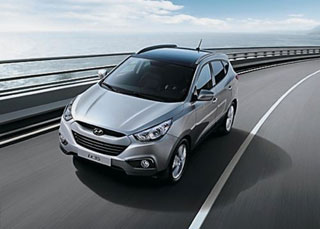 Hyundai IX35. Price: Not defined. On sale: since the spring of 2010
Hyundai IX35. Price: Not defined. On sale: since the spring of 2010 The second generation of the Hyundai Tucson, which is taking a market start under the IX35 index, turned out to be surprisingly diverse and contradictory. But, perhaps, it is precisely this series of contradictions in the nature of the CD-investor and is designed to help the Korean expand the army of his admirers
Test pilot
Vladimir Makkaveev, 32 years old, automobile journalist, driving experience 13 years, personal car - Volvo C30
Perhaps pass this test somewhere in a different place, such associations would not be as obvious as here on the Apennins in the cradle of ancient gods. But against the backdrop of the statues of Ancient Rome, the new is very diverse and not in everything the understandable character of the heir of Hyundai Tucson inspires even banal, but more than appropriate allusions. Koreans gave birth to a two -faced Janus. Western European versions of IX35 with gasoline and diesel engines are completely different in nature cars. Gemini is only a common look.
As befits the heir, the Hyundai IX35, compared to TUCSON, was a little fat and noticeably younger. Acceleration is the key to success in the modern automobile industry! The design, made in the Fluid Dynamic fashionable style, from which Antonio Gaudi’s modernism, implicated at the abstractionism of Salvador Dali, turned out to be an order of magnitude more complex, sophisticated. He will like it, perhaps not everyone, but the Korean will definitely add individuality and recognition. In general, the serial version of the IX35 externally differs little from the concept shown by Hyundai a year ago in Geneva. Side cut in the form of double Z, a wide and voluminous smile of a false radiator lattice. The same motives can be traced in the interior. The steering wheel pillow accurately copies the shape of the radiator, and the two -element door handles, like the outer cut, are adherents of liquid dynamics.
The sensory dashboard in the form of a diverging binoculars, once born by the imagination of Alfa Romeo designers, is unoriginal in itself, but in the interior of the Korean crossover it looks very stylish and harmonious. The central console has undergone a number of revolutionary changes, the main of which was the integration of the 6.5-inch monitor of the navigation system. A fashionable engine starting button has appeared. At the same time, the nest for the electronic key migrated to the central armrest: not new, but very original! I got IX35 and a number of fashionable lotions, such as a help system for descent and climbing a hill and an optional rear view camera. An increase in the external overalls: 80 mm in length and 20 mm in width gracefully affected the internal volume. The rear passengers feel on the couch more noticeably worse than in Tucson. The only thing that can somewhat disappoint in the IX35 interior is tiny, even by the standards of urban small -leafers, not to mention SUV, a glove compartment. But these are already details, but how different European versions of IX35 behave on the road, frankly intriguing!
An almost sports suspension for the crossover is unusually strict for the crossover, a dense and very heavy steering wheel of gasoline IX35 is confused. The rolls are completely absent, but each irregularity of the roadway is felt clearly. In principle, all this might seem to be a logical following new Korean fashion. In the end, the same accents on stiffness and handling are traced, for example, in the character of the Hyundai i20, in comparison with Getz. That's just in combination with albeit new, but significantly strangled by the Euro 5 163 -horsepower gasoline engine, the torque of which does not even up to 200 nm, the sports rigidity of the Hyundai IX35 does not look entirely in place. If the engine power is enough in the city, then on the freeway I would like more. Moreover, the already very acute non -adaptive steering wheel at high speeds becomes even more sharp, as if deliberately emphasizing the sports features in the character of the Korean. However, let's make a reservation: all this applies exclusively by the European version. In Russia, the disadvantages of gasoline IX35 are filled with the rejection of Euro 5 standards in favor of the more logical EURO 4 for our country, as well as a change in the characteristics of the elastic elements of the suspension. But in the all-wheel drive diesel version, on the contrary, to change something only to spoil.
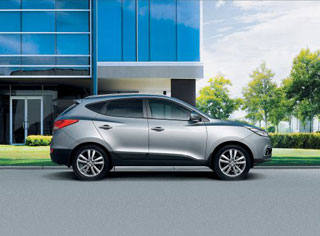 Unlike a gasoline counterpart, both 2-liter diesel engines are puffed with health. Twice large, in comparison with the gasoline version, the torque of the top -end 184 -horsepower turbodiesel transform the face of the Hyundai IX35 to recognition. However, the portrait of a more economical 136-horsepower diesel looks no worse: 320 Nm of torque is enough for him. And the suspension, which is specially worked for diesel engines, is an order of magnitude softer and more comfortable than gasoline. Perhaps in this version it is a bit lacks the transverse stability, which is why the diesel IX35 is tangibly roll in corners. But for the crossover, such rolls are by no means critical. The rest of the diesel IX35 is an order of magnitude more attractive than gasoline. Although, we repeat, all this applies only to Western European modifications. Before drawing conclusions regarding Russian versions, you should wait for a debut test drive adapted to Russia of the gasoline Hyundai IX35. Perhaps in Russia the Korean Janus will be not as two -faced as our new Roman acquaintance.
Unlike a gasoline counterpart, both 2-liter diesel engines are puffed with health. Twice large, in comparison with the gasoline version, the torque of the top -end 184 -horsepower turbodiesel transform the face of the Hyundai IX35 to recognition. However, the portrait of a more economical 136-horsepower diesel looks no worse: 320 Nm of torque is enough for him. And the suspension, which is specially worked for diesel engines, is an order of magnitude softer and more comfortable than gasoline. Perhaps in this version it is a bit lacks the transverse stability, which is why the diesel IX35 is tangibly roll in corners. But for the crossover, such rolls are by no means critical. The rest of the diesel IX35 is an order of magnitude more attractive than gasoline. Although, we repeat, all this applies only to Western European modifications. Before drawing conclusions regarding Russian versions, you should wait for a debut test drive adapted to Russia of the gasoline Hyundai IX35. Perhaps in Russia the Korean Janus will be not as two -faced as our new Roman acquaintance. Spring-summer in the Korean style
The gasoline versions of the Hyundai IX35 with a 150 -horsepower 2 -liter engine will be available in Russia from April at once in four modifications: cars with front and all -wheel drive are aggregated with a 5 -speed mechanical transmission, or with a 6 -speed automatic. All seven sets, from the cheapest front -wheel drive with manual transmission to a top -wheel all -wheel drive automated version of Prestige, are equipped with a pillow of the driver and front passenger, side safety pillows, front and rear passengers, active front strokes, front seat belts and ABS. Unlike Europe, in Russia, the gasoline engine will get rid of the strangling shackles of Euro 5 in favor of Euro 4. However, the nominal engine power will be only 150 liters. With. In principle, there is nothing wrong with this, especially if the Koreans manage to pull the ceiling of torque just in the Russian version. As for the adaptation of diesel versions of the Hyundai IX35 for Russia, which will appear in our market in the summer of 2010, even less is known about them. So how two -faced Korean Janus will be in Russia, time will tell.
We do not love
The engine button that has migrated from the sports cars becomes an indispensable SUV attribute. Modernly
The diverging dashboard binoculars replaced the boring tucson tidy. Sports
A nest for a key in a box of an armrest. Unusual
Driving
The widest range of modifications allows you not to adapt to the car, but to select IX35 for your priorities and your own control style.
Salon
An order of magnitude more modern and a little more spacious than the predecessor.
Comfort
Driving comfort depends significantly on the selected modification. Acoustic comfort does not cause complaints.
Safety
In Europe, the basic equipment includes a complete set of security systems, including ESP.
Price
Not determined.
Advantages and disadvantages
+ Bright design, a wide range of modifications that determines the diverse of the characters of the model
- not the most outstanding power indicators of the gasoline engine, transverse rolls in diesel engines
Technical science characteristics
Mark and model - Hyundai IX35
Dimensions - 4410x1820x1660 mm
Engine - gasoline, 1998 cm3, 163 l. S./6200 min--1
Transmission - mechanical, 5 -speed KP
Dynamics - max 184 km/h; 10.4 s to 100 km/h
Competitors - Nissan Qashqai, Ford Kuga, VW Tiguan
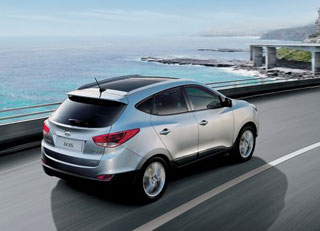
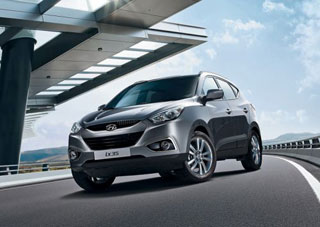
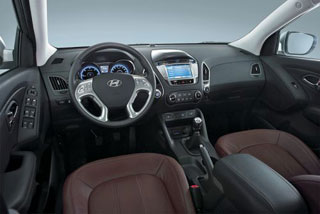
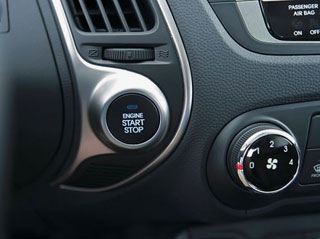
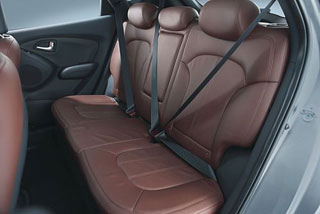
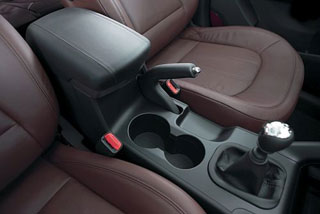
Author: Vladimir Makkaveev
Source: Magazine 5 wheel [April 2010]
Hyundai IX35 (TUCSON) Video Video since 2009
Hyundai IX35 (TUCSON) Krash Video since 2009
Hyundai IX35 (TUCSON) test drives since 2009
Hyundai IX35 (TUCSON) Krash Test since 2009
Krassh Test: Detailed Information90%
Driver and passengers
54%
Pedestrians
88%
Children-passengers
71%
Active security system

